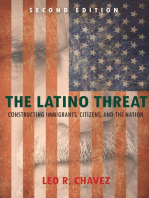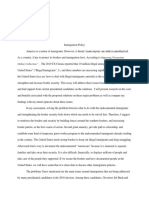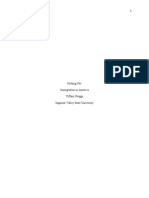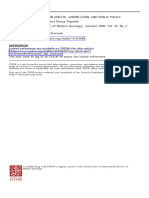0 ratings0% found this document useful (0 votes)
46 viewsSources
Sources
Uploaded by
api-4543270881. This document summarizes 8 sources that discuss various aspects of immigration to the United States, including characteristics of legal and illegal immigrants, unauthorized immigration flows and estimates, public opinions on immigration policies, border enforcement strategies, principles for long-term immigration reform, the impact of state work eligibility laws, and earnings differences between legal and illegal Mexican immigrants.
2. Many of the sources analyze data from surveys, government agencies, and research studies to provide empirical evidence on the size and characteristics of immigrant populations in the US and how immigration policies have impacted migration trends and enforcement approaches.
3. The sources cover a range of topics but generally explore the challenges with developing effective and humane immigration policies given the complex dynamics between border security,
Copyright:
© All Rights Reserved
Available Formats
Download as PDF, TXT or read online from Scribd
Sources
Sources
Uploaded by
api-4543270880 ratings0% found this document useful (0 votes)
46 views4 pages1. This document summarizes 8 sources that discuss various aspects of immigration to the United States, including characteristics of legal and illegal immigrants, unauthorized immigration flows and estimates, public opinions on immigration policies, border enforcement strategies, principles for long-term immigration reform, the impact of state work eligibility laws, and earnings differences between legal and illegal Mexican immigrants.
2. Many of the sources analyze data from surveys, government agencies, and research studies to provide empirical evidence on the size and characteristics of immigrant populations in the US and how immigration policies have impacted migration trends and enforcement approaches.
3. The sources cover a range of topics but generally explore the challenges with developing effective and humane immigration policies given the complex dynamics between border security,
Original Title
sources
Copyright
© © All Rights Reserved
Available Formats
PDF, TXT or read online from Scribd
Share this document
Did you find this document useful?
Is this content inappropriate?
1. This document summarizes 8 sources that discuss various aspects of immigration to the United States, including characteristics of legal and illegal immigrants, unauthorized immigration flows and estimates, public opinions on immigration policies, border enforcement strategies, principles for long-term immigration reform, the impact of state work eligibility laws, and earnings differences between legal and illegal Mexican immigrants.
2. Many of the sources analyze data from surveys, government agencies, and research studies to provide empirical evidence on the size and characteristics of immigrant populations in the US and how immigration policies have impacted migration trends and enforcement approaches.
3. The sources cover a range of topics but generally explore the challenges with developing effective and humane immigration policies given the complex dynamics between border security,
Copyright:
© All Rights Reserved
Available Formats
Download as PDF, TXT or read online from Scribd
Download as pdf or txt
0 ratings0% found this document useful (0 votes)
46 views4 pagesSources
Sources
Uploaded by
api-4543270881. This document summarizes 8 sources that discuss various aspects of immigration to the United States, including characteristics of legal and illegal immigrants, unauthorized immigration flows and estimates, public opinions on immigration policies, border enforcement strategies, principles for long-term immigration reform, the impact of state work eligibility laws, and earnings differences between legal and illegal Mexican immigrants.
2. Many of the sources analyze data from surveys, government agencies, and research studies to provide empirical evidence on the size and characteristics of immigrant populations in the US and how immigration policies have impacted migration trends and enforcement approaches.
3. The sources cover a range of topics but generally explore the challenges with developing effective and humane immigration policies given the complex dynamics between border security,
Copyright:
© All Rights Reserved
Available Formats
Download as PDF, TXT or read online from Scribd
Download as pdf or txt
You are on page 1of 4
1.
Empirical characteristics of legal and illegal immigrants in the USA
Caponi, Vincenzo, and Miana Plesca. "Empirical Characteristics of Legal and Illegal Immigrants
in the USA." Journal of Population Economics, vol. 27, no. 4, 2014, pp. 923-960.
ProQuest,
https://login.proxy039.nclive.org/login?url=https://search.proquest.com/docview/154838
4124?accountid=10163, doi:http://dx.doi.org/10.1007/s00148-014-0524- x.
In this article I will use it to write about empirical characteristics of legal and illegal immigrants
in the United States. This article will “combine the New Immigrant Survey (NIS), which
contains information on US legal immigrants, with the American Community Survey (ACS),
which contains information on legal and illegal immigrants to the USA.” Another thing in this
article that will be used is “to use information on legal and illegal migrants from Mexico using
data available from the Mexican Migration Project (MMP), whose aim is to collect information
on the legal and illegal Mexican migration to the USA.” Here is another thing in the article
“while illegal immigrants suffer a large wage penalty compared to legal immigrants at all
education levels, the penalty decreases with education. We also find that the total fertility rate
among illegal immigrant women is significantly higher than that among legal ones, in particular
for middle and higher educated women.”
2. Unauthorized immigration to the United States
Espenshade, Thomas J. "Unauthorized Immigration to the United States." Annual Review of
Sociology, vol. 21, 1995, pp. 195. ProQuest,
https://login.proxy039.nclive.org/login?url=https://search.proquest.com/docview/199
732593?accountid=10163.
“Illegal immigration to the United States is in the public eye once again.” is how this article
started out which is good. “Because the volume of illegal US immigration is not directly
observed, studies of the gross flow of undocumented migration across the Mexico-United States
border have typically invoked Immigration and Naturalization Service (INS) data on the number
of border apprehensions of unauthorized aliens as a proxy for the size of the illegal migrant
flow.” Another thing is “the gross flow of authorized aliens is not the same as the net flow,
because many illegal aliens depart the United States each year. Researchers at the US Bureau of
the Census estimate that the size of the US undocumented alien population grew by an average
annual amount somewhere between 100,000 and 300,000 during the period from 1980 to 1983.”
3. Growing Divide on Immigration and America’s Moral Leadership.
Growing Divide on Immigration and America’s Moral Leadership. Public Religion Research
Institute, Washington, 2018. ProQuest,
https://login.proxy039.nclive.org/login?url=https://search.proquest.com/docview/206233
1639?accountid=10163.
In this little article it tells the percentage of how many people want the want different things to
happen in the United States. And how fewer than half of the public believes that the U.S. sets a
good moral example for the rest of the world. And how “Americans largely reject the policy
whereby families entering the country without permission are treated as criminals and children
are separated from their parents.” In this article it will show how the people of the United States
have very different opinion. A lot of people argue that the U.S. should provide refuge and
protection for people who come to the U.S. when they are facing serious danger in their home
country. It's like house divided when it comes to parties, “Americans are divided over who they
trust to handle the immigration issue. Thirty-eight percent of the public say they most trust the
Democrats in Congress to deal with immigration issues while a nearly equal number say they
trust the Republicans in Congress.
4. "Border Enforcement, Organized Crime, and Deaths of Smuggled Migrants on the United
States - Mexico Border."
Guerette, Rob T., and Ronald V. Clarke. "Border Enforcement, Organized Crime, and Deaths of
Smuggled Migrants on the United States - Mexico Border."European Journal on
Criminal Policy and Research, vol. 11, no. 2, 2005, pp. 159-174. ProQuest,
https://login.proxy039.nclive.org/login?url=https://search.proquest.com/docview/222824
164?accountid=10163, doi:http://dx.doi.org/10.1007/s10609-005-6716-z.
In this source I will be able to talk about illegal immigrants entering the United States from
Mexico. “Prior to the early 1990s, the problem of illegal immigration along the U.S. and Mexico
border was relatively uncontrolled.” Also, before 1990 “immigrates from throughout Central and
South America and Mexico could travel to border towns and simply walk or run into the United
States. Once there, they would quickly disappear into U.S. towns and cities.” But in this article,
it will also show how in 1990 we did several things like increasing the number of Border Patrol
agents directly on the border, the erection of walls at heavy traffic areas, and insertion of
electronic surveillance systems. But that still isn’t enough, it also resulted in an increased
reliance on human smugglers. Still in deporting them it still didn’t work, because a good
percentage of the immigrates just come back across the border when they get dropped off. Also,
implications for future border policing strategy and research are discussed.
5. Moving Beyond Comprehensive Immigration Reform and Trump: Principles, Interests,
and Policies to Guide Long-Term Reform of the US Immigration System
Kerwin, Donald. "Moving Beyond Comprehensive Immigration Reform and Trump:
Principles, Interests, and Policies to Guide Long-Term Reform of the US Immigration
System." Journal on Migration and Human Security, vol. 5, no. 3, 2017. ProQuest,
https://login.proxy039.nclive.org/login?url=https://search.proquest.com/docview/192
8165340?accountid=10163.
“This paper introduces a special collection of 15 papers that chart a course for long-term
reform of the US immigration system. The papers look beyond recent legislative debates and
the current era of rising nationalism and restrictions to outline the elements of a forward-
looking immigration policy that would serve the nation’s interests, honor its liberal
democratic ideals, promote the full participation of immigrants in the nation’s life, and
exploit the opportunities offered by the increasingly interdependent world.” This basically
said what I was thinking but another thing in this article is that “Seventy percent of US crop
workers were born in Mexico and 70 percent of foreign-born crop workers lack immigration
status” “Yet, not all of these considerations align with the profile of Trump supporters. One
pre-election analysis, for example, found “no clear picture between social and economic
hardship and support for Trump” and “no link whatsoever between greater exposure to trade
competition or competition from immigrant workers and support for nationalist policies in
America”
6. Election of Donald Trump and migration
Martin, Philip L. "Election of Donald Trump and Migration." Migration Letters, vol. 14, no.
1, 2017, pp. 161-171. ProQuest,
https://login.proxy039.nclive.org/login?url=https://search.proquest.com/docview/202
8852923?accountid=10163.
This source right here will tell you about what Donald Trump wanted to build the wall and
the take on how people take it. “Donald Trump campaigned on seven major issues, two of
which involved migration, viz, have the US build and Mexico pay for a wall on the 2,000-
mile Mexico-US border and deport the 11 million unauthorized foreigners in the US (Martin
1).”
7. Do state work eligibility verification laws reduce unauthorized immigration?
Orrenius, Pia M., and Madeline Zavodny. "Do State Work Eligibility Verification Laws Reduce
Unauthorized Immigration?" IZA Journal of Migration, vol. 5, no. 1, 2016, pp. 1-17.
ProQuest,
https://login.proxy039.nclive.org/login?url=https://search.proquest.com/docview/181305
9333?accountid=10163, doi:http://dx.doi.org/10.1186/s40176-016-0053-3.
This source will help me expand my look on how state work eligibility verification laws will
help cut down on illegal immigration. Back in the 2000s, several states acquired laws forcing
employers to verify new employees' eligibility to work legally in the United States of
America. “This study uses data from the2005-2014 American Community Survey to examine
how such laws affect unauthorized immigrants' locational choices. The results indicate that
having an E-Verify law reduces the number of less-educated prime-age immigrants from
Mexico and Central America--immigrants who are likely to be unauthorized--living in a state
(Orrenius 1).” In the late 2000’s, multiple of these laws were aimed at cutting down the
unpermitted immigrant population. With state lawmakers claiming they were responding to
stagnation by the federal government. “In 2007, before the Great Recession, it totaled about
12.2 million and 30 % of all immigrants living in the USA (Orrenius 1).”
8. Undocumented workers in the labor market: An analysis of the earnings of legal and
illegal Mexican immigrants in the United States
Rivera-Batiz, Francisco. "Undocumented Workers in the Labor Market: An Analysis of the
Earnings of Legal and Illegal Mexican Immigrants in the United States."Journal of
Population Economics, vol. 12, no. 1, 1999, pp. 91-116. ProQuest,
https://login.proxy039.nclive.org/login?url=https://search.proquest.com/docview/230
438334?accountid=10163.
This article shows in earnings between Mexican legal and illegal immigrants in the United
States. “The analysis includes a cross-sectional examination of the wage differences between
legal and undocumented workers as well as a longitudinal analysis examining the impact of
legalization on the earnings of previously-undocumented workers. It is shown that the average
hourly wage rate of male Mexican legal immigrants in the United States was 41.8% higher than
that of undocumented workers while female legal immigrants earned 40.8% more.” Another
thing that I see that’s interesting One of the key issues surrounding undocumented workers is the
extent to which they are exploited, or discriminated against, in host country labor markets by
being paid wages that are substantially below those paid to legal workers with identical
characteristics.” The article also states that illegal immigrants get paid less than your normal and
average legal person working a job.
You might also like
- The Latino Threat: Constructing Immigrants, Citizens, and the Nation, Second EditionFrom EverandThe Latino Threat: Constructing Immigrants, Citizens, and the Nation, Second EditionRating: 5 out of 5 stars5/5 (1)
- Kami Export - Unit - III - Study - Guide - Branches - of - Government PDFDocument3 pagesKami Export - Unit - III - Study - Guide - Branches - of - Government PDFOdwin Gonzalez PachecoNo ratings yet
- AL His Inter CB Answers PDFDocument33 pagesAL His Inter CB Answers PDFVasia PapageorgiouNo ratings yet
- Inside the State: The Bracero Program, Immigration, and the I.N.S.From EverandInside the State: The Bracero Program, Immigration, and the I.N.S.No ratings yet
- Issue ReportDocument5 pagesIssue Reportapi-454327088No ratings yet
- AllannotatedbibliographyDocument18 pagesAllannotatedbibliographyapi-349377060No ratings yet
- Borderland Immigration 1Document17 pagesBorderland Immigration 1api-402243879No ratings yet
- Round Table Essay DraftDocument6 pagesRound Table Essay Draftapi-353337672No ratings yet
- Illegal Migration From Mexico To The US (Dec 2006)Document57 pagesIllegal Migration From Mexico To The US (Dec 2006)Generic_Persona100% (1)
- IllegalimmigrationDocument6 pagesIllegalimmigrationapi-305336756No ratings yet
- Ethnicity & Immigration Reader SampleDocument136 pagesEthnicity & Immigration Reader SamplecqpresscustomNo ratings yet
- Thesis Statement On Mexican ImmigrationDocument7 pagesThesis Statement On Mexican ImmigrationBuyCollegePaperOnlineUK100% (2)
- Essay #5 - The Immigration DebateDocument7 pagesEssay #5 - The Immigration DebatebcjacksondawgNo ratings yet
- References Artifact Bailey PetersonDocument12 pagesReferences Artifact Bailey Petersonapi-253524558No ratings yet
- Persuasion Effect Project Final Revision-2Document16 pagesPersuasion Effect Project Final Revision-2api-589370067No ratings yet
- Massey BorderEnforcementBackfired 2016Document45 pagesMassey BorderEnforcementBackfired 2016YuniNo ratings yet
- America Is A Nation of ImmigrantsDocument5 pagesAmerica Is A Nation of Immigrantssaron getahunNo ratings yet
- Handcuffs and Chain Link: Criminalizing the Undocumented in AmericaFrom EverandHandcuffs and Chain Link: Criminalizing the Undocumented in AmericaNo ratings yet
- Mexican Migration to the United States: Perspectives From Both Sides of the BorderFrom EverandMexican Migration to the United States: Perspectives From Both Sides of the BorderNo ratings yet
- Argumentative Essay Sample On ImmigrationDocument5 pagesArgumentative Essay Sample On ImmigrationAmeena AimenNo ratings yet
- MCRPDocument6 pagesMCRPapi-336558320No ratings yet
- The Land of ImmigrantsDocument5 pagesThe Land of Immigrantsapi-418122023No ratings yet
- Illegal Immigration Literature ReviewDocument6 pagesIllegal Immigration Literature Reviewafmzsprjlerxio100% (1)
- Annotated PolishedDocument9 pagesAnnotated Polishedapi-271451582No ratings yet
- James Cazares Annotated BibDocument7 pagesJames Cazares Annotated BibjNo ratings yet
- Running Head: MELTING POT 1: Melting Pot: Immigration in America Tiffany Briggs Saginaw Valley State UniversityDocument7 pagesRunning Head: MELTING POT 1: Melting Pot: Immigration in America Tiffany Briggs Saginaw Valley State UniversityTiffany BriggsNo ratings yet
- Here's The Reality About Illegal Immigrants in The United StatesDocument5 pagesHere's The Reality About Illegal Immigrants in The United StatesCharles AbelNo ratings yet
- The Impact of Immigration On The State of Texas and Related Electoral PoliciesDocument7 pagesThe Impact of Immigration On The State of Texas and Related Electoral PoliciesBessa Kwao-AdoteyNo ratings yet
- Sample Argumentative EssayDocument5 pagesSample Argumentative EssayMinamiNo ratings yet
- The Rolr of Drug-Related Violence and Extortio in Promoting Mexican MigrationDocument20 pagesThe Rolr of Drug-Related Violence and Extortio in Promoting Mexican MigrationClaudia Romero InfanteNo ratings yet
- Literature Review Illegal ImmigrationDocument8 pagesLiterature Review Illegal Immigrationafdtsxuep100% (1)
- InstructionsDocument4 pagesInstructionsvlad vladNo ratings yet
- Undocumented Immigration and Rates of Crime and Imprisonment: Popular Myths and Empirical Realities, by Ruben G. RumbautDocument25 pagesUndocumented Immigration and Rates of Crime and Imprisonment: Popular Myths and Empirical Realities, by Ruben G. RumbautJ Cox100% (1)
- 8 Reasons To Close The Border NowDocument3 pages8 Reasons To Close The Border Nowshelby parkerNo ratings yet
- Illegal Immigration Positive Economic NadadurDocument18 pagesIllegal Immigration Positive Economic NadadurDino DžinoNo ratings yet
- Immigration Reform Essay ThesisDocument8 pagesImmigration Reform Essay Thesismichellebenedictcambridge100% (1)
- Essay: Immigration LawDocument8 pagesEssay: Immigration LawWriting OnlineNo ratings yet
- wola.org-Weekly US-Mexico Border Update The return of TrumpDocument7 pageswola.org-Weekly US-Mexico Border Update The return of TrumpJosé Leobardo AguilarNo ratings yet
- Project 2 Final Draft 1Document11 pagesProject 2 Final Draft 1api-419025835No ratings yet
- McresearchpaperDocument4 pagesMcresearchpaperapi-336698797No ratings yet
- Reforming Immigration Policy and ProceduresDocument8 pagesReforming Immigration Policy and ProceduresSharon LeveronNo ratings yet
- Capstone FinalDocument38 pagesCapstone FinalAlexandraMu92No ratings yet
- Sofia Rada - 10 ClipsDocument20 pagesSofia Rada - 10 ClipsSofia RadaNo ratings yet
- Formal EssayDocument5 pagesFormal EssayPatson PapitoNo ratings yet
- Book - Research Thesis PaperDocument6 pagesBook - Research Thesis Paperapi-345470402No ratings yet
- Domestic and Foreign Policy Essay: Immigration: Salt Lake Community CollegeDocument6 pagesDomestic and Foreign Policy Essay: Immigration: Salt Lake Community Collegeapi-533010636No ratings yet
- Running Header: Effects of Illegal Immigration On America 1Document13 pagesRunning Header: Effects of Illegal Immigration On America 1writer topNo ratings yet
- Immigtation in Usa Dieudonne MusareDocument4 pagesImmigtation in Usa Dieudonne Musareapi-252831439No ratings yet
- 03-19-08 WFP SpitzerDocument8 pages03-19-08 WFP SpitzerHouston Criminal Lawyer John T. FloydNo ratings yet
- ManilaMail - Feb. 28, 2013Document32 pagesManilaMail - Feb. 28, 2013Winona WriterNo ratings yet
- The New Ellis Island: Visions From The Border For The Future of AmericaDocument62 pagesThe New Ellis Island: Visions From The Border For The Future of AmericaThe Border Network for Human RightsNo ratings yet
- Mexican Immigration ThesisDocument6 pagesMexican Immigration Thesisafbteepof100% (3)
- Health Care in US Detention Centers - Ethical Analysis From The Preferential Option For The Poor - Miguel Ceron Becerra 2021Document26 pagesHealth Care in US Detention Centers - Ethical Analysis From The Preferential Option For The Poor - Miguel Ceron Becerra 2021Miguel CbNo ratings yet
- Illegal People: How Globalization Creates Migration and Criminalizes ImmigrantsFrom EverandIllegal People: How Globalization Creates Migration and Criminalizes ImmigrantsRating: 5 out of 5 stars5/5 (2)
- AssignmentDocument7 pagesAssignmentKaleem SiddiquiNo ratings yet
- The Mexican Immigration Debate: Assimilation and Public PolicyDocument16 pagesThe Mexican Immigration Debate: Assimilation and Public Policyshabbirezzy79No ratings yet
- Rallying for Immigrant Rights: The Fight for Inclusion in 21st Century AmericaFrom EverandRallying for Immigrant Rights: The Fight for Inclusion in 21st Century AmericaNo ratings yet
- After ICE Arrests, Fear Spreads Among Undocumented ImmigrantsDocument4 pagesAfter ICE Arrests, Fear Spreads Among Undocumented ImmigrantstanyaNo ratings yet
- Final Presentation Research ProjectDocument23 pagesFinal Presentation Research Projectapi-302322538No ratings yet
- Fact Check On Illegal ImmigrationDocument9 pagesFact Check On Illegal ImmigrationRoy WardenNo ratings yet
- Tony Smith The Logic of Marxs Capital Replies To Hegelian CriticismsDocument147 pagesTony Smith The Logic of Marxs Capital Replies To Hegelian CriticismsJuan Hermidas100% (3)
- Rizal Activities 4,5,6Document3 pagesRizal Activities 4,5,6Paps82% (11)
- General Paper Questions.Document54 pagesGeneral Paper Questions.amodum1784No ratings yet
- Analysis of African Poem by Agostinho NetoDocument2 pagesAnalysis of African Poem by Agostinho NetoMerche RouxNo ratings yet
- International Summits: Upsc InfographicsDocument12 pagesInternational Summits: Upsc InfographicsVarun PatilNo ratings yet
- Notifications by Government: Part I ExtraordinaryDocument1 pageNotifications by Government: Part I ExtraordinaryRaghuNo ratings yet
- The Chinese Statue-AnswersDocument9 pagesThe Chinese Statue-AnswersDhruvi MittalNo ratings yet
- RT Time Table Css 2022Document2 pagesRT Time Table Css 2022Abdul Basit SolangiNo ratings yet
- Lahore PPDocument551 pagesLahore PPM Asif Naveed0% (1)
- ENG1501 Assignment 3 18192173Document11 pagesENG1501 Assignment 3 18192173Sune StewartNo ratings yet
- Introduction To Politics UnitDocument2 pagesIntroduction To Politics Unitapi-375642225No ratings yet
- Adam by Ariel Schrag - Discussion QuestionsDocument3 pagesAdam by Ariel Schrag - Discussion QuestionsHoughton Mifflin HarcourtNo ratings yet
- Marco D'Eramo, They The People, NLR 103, January-February 2017Document10 pagesMarco D'Eramo, They The People, NLR 103, January-February 2017LuisNo ratings yet
- Civil Disobedience Movement (1930-34)Document6 pagesCivil Disobedience Movement (1930-34)NIRAKAR PATRANo ratings yet
- SF5-Ireland On The RackDocument4 pagesSF5-Ireland On The RackGerald J DowningNo ratings yet
- List of Approved TOsDocument44 pagesList of Approved TOsjust.kidding.loll5No ratings yet
- Motion Prove ArgumentsDocument2 pagesMotion Prove Argumentsrhane vediosNo ratings yet
- Asia in The New MillenniumDocument14 pagesAsia in The New MillenniumKayeden CubacobNo ratings yet
- IDFCDocument838 pagesIDFCayaanNo ratings yet
- PKN OkDocument3 pagesPKN OkIrma ElyNo ratings yet
- Margaret Chase Smith: "Conscience of The Senate"Document6 pagesMargaret Chase Smith: "Conscience of The Senate"Ingrid HolmquistNo ratings yet
- ISO Tolerances For Holes (ISO 286-2)Document2 pagesISO Tolerances For Holes (ISO 286-2)srinivignaNo ratings yet
- WCPU Directory 2024-01-01Document14 pagesWCPU Directory 2024-01-01Jenevive PaurongNo ratings yet
- Rashid JDocument9 pagesRashid JRavi Ravi NNo ratings yet
- Antony Flew - The Politics of Procrustes - Contradictions of Enforced Equality (1981, Prometheus Books)Document194 pagesAntony Flew - The Politics of Procrustes - Contradictions of Enforced Equality (1981, Prometheus Books)Matías Calero PérezNo ratings yet
- The Conaissance Anthem Book IDocument105 pagesThe Conaissance Anthem Book IJohncel James Dela RosaNo ratings yet
- Federalism Board QuestionDocument13 pagesFederalism Board QuestionmeenulakshmanaNo ratings yet
- Hurt Feelings ReportDocument1 pageHurt Feelings Reportsnroller1No ratings yet

























































































